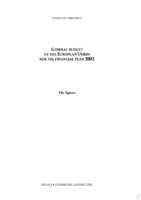| dc.description.abstract | GENERAL PRESENTATIONThe 2002 general budget of the European Union was adopted after the European Parliament’s secondreading on 13 December 2001.It totalsQ98 635 million in commitment appropriations and 95 655 million in paymentappropriations. Compared to 2001 including the different Supplementary and Amending Budgetsthese figures represent a very modest increase of 1,7 % in commitment appropriations and 2 % inpayment appropriations. For the third year in a row the flexibility instrument has been mobilised: thistime for structural actions in heading 2. This leaves nevertheless a margin ofQ2 204 million incommitmentappropriationsundertheglobalceiling.Thepaymentappropriationscorrespondtoonly1,03 % of EU GNP, which is historical low and leavesQ4 590 million under the ceiling of 1,14 % of EUGNP as in the Financial Perspective.The appropriations foragricultural expendituretotalQ44 255 million, representing a 0.5 %increase on 2001. This amount breaks down intoQ39 660 million for subheading 1a (marketexpenditure), decided on the basis of the updated figures proposed by the Commission in letter ofamendment 2/2002. This Amending Letter brought considerable savings compared to the PDB as itproposed the deletion of theQ1 bio reserve for the BSE and FMD crises. In addition, subheading 1abenefited from a generally favourable world market situation and a drop in consumption in the beefmarket that turned less drastic than what had initially been feared. This Amending Letter was agreedin a single reading at the conciliation meeting on 21 November, which hammered out the key aspectsof the 2002 budget. For subheading 1b (Rural development and accompanying measures), theQ4 595 million adopted corresponds to the ceiling.Expenditure forstructural operations,heading 2 of the Financial Perspective totalsQ33 838 millionfor commitments andQ32 129 million for payments. This includesQ31 049 million in commitmentappropriations for the Structural Funds, orQ200 million more than the ceiling set in the FinancialPerspective thanks to the mobilisation of the flexibility reserve, andQ29 529 million in paymentappropriations. In addition to the programmed envelopes, this will allow the financing of substantialfirst tranche ofQ170 million for the restructuring programme of the fisheries fleet in Spain andPortugal as a consequence of the non-renewal of the international fisheries agreement with Morocco.At the conciliation meeting in November it was also agreed to useQ30 million from the flexibilityinstrument for the border regions with candidate countries to improve their competitiveness inpreparationforenlargement.ThetwoactionsfollowfromtheNiceEuropeanCouncilconclusionsandwill be completed in 2003.
For the Cohesion Fund,Q2 789 million are available for commitments, as provided in the FinancialPerspective, andQ2 600 million for payments.Appropriations forinternal policies,heading 3 of the Financial Perspective totalQ6 558 million forcommitments andQ6 157 million for payments. The margin available for the heading is onlyQ186 400 and the increase over 2001 is 5,2 %. In accordance with the wishes of the Council andParliament, the new priorities in the 2002 budget focus on e-learning and immigration and asylum,as well as border regions. The pilot project on the impact of enlargement on SME has been allocatedQ20 million. TheQ4 055 million in commitment appropriations allocated to the researchprogrammes in sub-section B6 is 3,4 % up on 2001. The total available for payments in the researchareaisQ3 752 million.Theothersectorswithlargeincreasesare:areaforfreedom,securityandjustice;transport; environment; internal market and combatting fraud.Under theexternal actionheading 4 the main feature of the 2002 budget procedure was thediscussion on the financing of the consequences of the Afghan crisis. The allocations totalQ4 803 million for commitments andQ4 665 million for payments. The commitments decrease over2001 by 2,5 %, 2001 taking into account the use of the flexibility instrument for an amount ofQ200 million in favour of Serbia. This compares with an increase of 6,7 % for payments and reflects theconcentration on closing outstanding commitments. For Afghanistan the Asia geographicprogramme has been increased toQ488 million, of which 60 million for Afghanistan andneighbouring countries. Of the remaining margin at leastQ70 million have been earmarked forAfghanistan, as have beenQ35 million from the emergency aid reserve that might be called upon. TheWestern Balkans allocation amounts toQ765 million, thanks to a further frontloading that was madepossible during 2001. The Mediterranean envelope, including the MEDA programmes, totalsQ861 million, and should cater for the Palestine. The CFSP appropriations were reduced during theconciliation meeting toQ30 million.Appropriations foradministrative expendituretotalQ5 177 million, an increase of 4,8 % over2001. This figure includes the appropriations for the 317 new posts for the Commission, theappropriations for 70 posts are however kept in the reserve pending additional proposals by theCommission on better matching between legislative and financial programmes and the earlyretirement scheme.For the other institutions, the total budget isQ1 789 million. Expenditure on pensions is the part ofthe heading with the largest increase (11,3 %). The total margin still remaining in heading 5 for 2002is onlyQ2,2 million.The appropriations forpre-accession aidin heading 7 totalQ3 328 million for commitments, equalto the ceiling for the heading (excluding Cyprus, Malta and Turkey). After the start-up problems, thepayment appropriations now have to cover reimbursements as well as advance payments and theincrease is a substantial 23,5 %, but still below the commitment appropriations.Finally, as concerns the financing, due to delays in the adoption procedure of the new own resourcesdecision, Amending Letter 3/2002 presented and adopted only in December re-based the 2002financing on the current own resources decision. |

